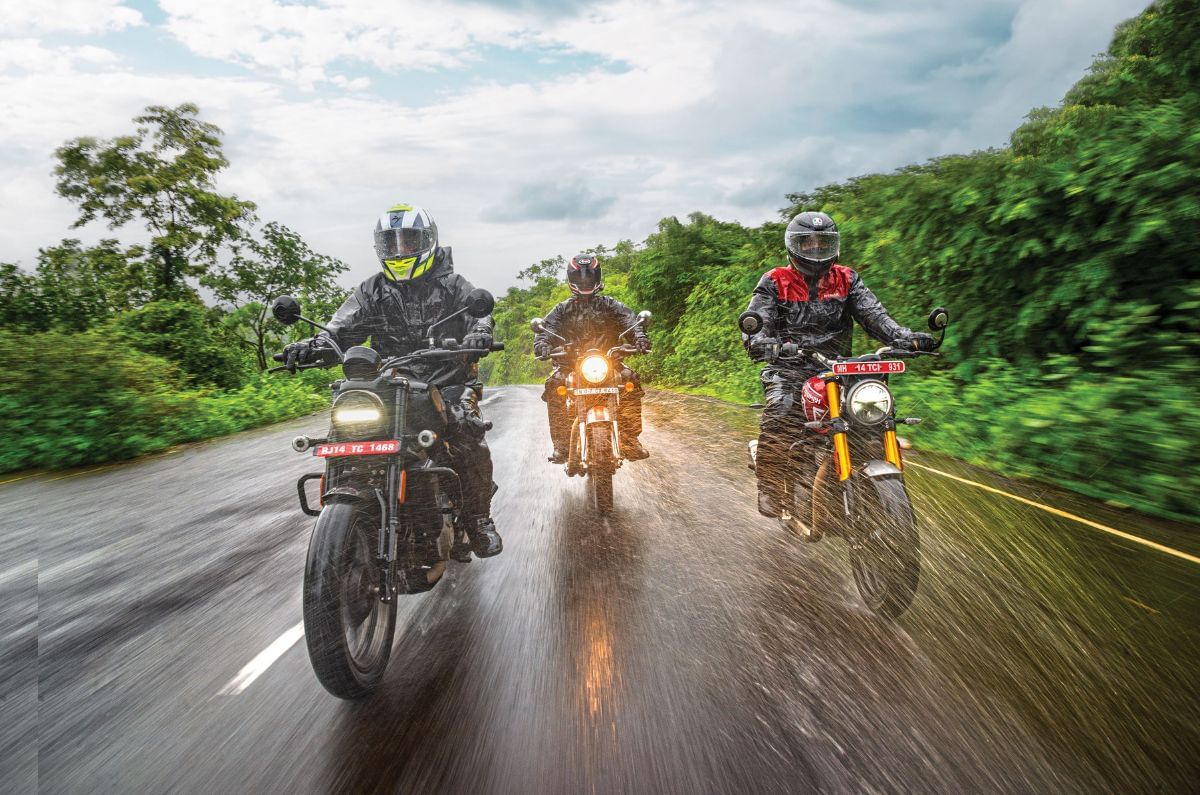
With the monsoon kickstarting sooner than anticipated, here are a few tips and tricks to prepare your two-wheeler and yourself for the upcoming showers and wet riding conditions.
Change your riding style
Be smooth and progressive with your inputs.
Better control
Given the reduced grip levels, all your inputs need to be smoother to avoid exceeding this limited traction threshold. Avoid any sudden actions on the motorcycle. As much as possible, do not rapidly open the throttle, suddenly clamp down on the brakes really hard, or steer the bike aggressively. Such jerky movements can very easily overwhelm the limited amount of traction available to your tyres, possibly causing you to be thrown into an unfortunate situation.
Right braking techniques
Proper braking techniques become even more essential in wet conditions. If your bike has ABS, it will let you slam the brakes hard on wet roads without locking up, but if it doesn’t, you have to be extra careful when braking. Again, it’s essential to be progressive with your inputs. Learn to feel what the tyres are doing when you apply the brakes. When you sense the tyres are about to lock, ease off the brakes a little.
Right mode
A lot of motorcycles these days happen to be equipped with electronic aids such as ABS modes and riding modes. Knowing how these modes affect your motorcycle can make quite a huge difference. For instance, while Rain Mode generally dulls the throttle response, which is good on slick roads, it can also increase ABS intervention. The latter means you will need to be mindful of applying the brakes more preemptively than you’re used to to prevent prolonged ABS intervention, which can extend braking distances. If the surface you’re on isn’t too wet or begins to dry, make sure to promptly switch to Road Mode as this will allow the ABS to intervene less and provide better braking performance.

Kill speeds
The first showers of the year are exceptionally treacherous, since these tend to leech out the oils and grime from the road surface, making it extra slippery. Keeping speeds lower than normal is recommended throughout the monsoon, but especially so during the initial few weeks.
Unsafe lines
Road markings such as lane separators, zebra crossings, and even manhole covers tend to be extra slippery when wet. Avoid riding over them as much as possible. Also, refrain from riding in the centre of a lane since that is where other vehicles tend to leak oil and other fluids. Instead, stick to one side and follow a vehicles’ wheel tracks. It will not only save you from the dropped fluids but also help you benefit from a drier surface since other vehicles have displaced water in these areas.
Maintain social distancing
Braking distances are longer in the wet, so remember to maintain more distance from vehicles ahead of you than you normally would. This gives you extra room to slow down and also helps you avoid the spray from rear tyres.
Headlights on
Even if it is just overcast and not raining, it’s advisable to ride with your headlight on (not just your DRLs). The gloomy conditions in the monsoons reduce contrast, so running your headlight helps make you more visible to other road users, which is also why one wears high-visibility riding gear.
No splashes, please
While it might be fun to splash through a puddle, avoid it as much as possible. If the puddle is deeper than you expected, the sudden deceleration might make you lose control. Plus, on our roads, there’s a good chance a deep pothole is lurking under all that standing water. If riding through standing water is unavoidable, then it’s best to keep a slower speed, a lower gear, and ride through with a constant throttle. It will help avoid a big splash that might just allow water to creep into the spark plug region. It’s also worth keeping in mind that your actions have consequences, and fellow road users and pedestrians may not enjoy water splashes as much as you do.
In the corners

While we all enjoy corner carving around our favourite ghat road, monsoon demands a slightly different approach
No sudden movements
As long as you don’t make any sudden movements on the bike, things should be just fine. Shift your body into position gradually and smoothly, and make sure your brake, throttle and steering inputs are as smooth as possible to maintain optimal traction.
Optimise grip
You are not going to be able to carry the same lean angles in the wet as you do in the dry. So, choose lines and speeds that will allow you to keep your bike more upright, ensuring you have more grip in the turns.
Avoid trail-braking
Follow this irrespective of whether your bike has ABS. Suddenly slowing down when your bike is leaned over on a wet road can cause the front end to tuck in and result in you ending up on the pavement. As far as possible, scrub off your speed in a straight line before pitching your motorcycle into the turn. The only exception to this is motorcycles that come with IMU-based cornering ABS, which are more successful at keeping you upright when braking while leaning over.
Also see: Most affordable bikes with ABS in India

